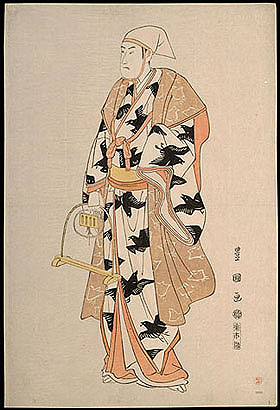|
It is
interesting to note that both Toyokuni and Sharaku were making
images of the same actors with the same decorative costumes
in the same roles at the Miyako-za during the 1794 performances.
Since certain of Toyokuni's designs appeared earlier that
year than the same designs by Sharaku, it would appear that
Sharaku may have been influenced by Toyokuni. It seems quite
clear that they knew each other, but the extent of that relationship
will never be known.

illustration 3
During this same period from 1795 to
1800, Izumiya Ichibei published another series of actor prints
for Toyokuni identical to the 'Views of Actors on Stage',
but with no identifying series title. These are also full-length
figures against a gray ground. Like the series mentioned earlier,
this group has never been adequately cataloged. It contains
many wonderful studies of actors caught in moments of great
suspense.
|
 |
Toyokuni employed
his full power as an artist and created in these images a
style quite distinctive from any other. His power of observation
was acute and focused on the drama being conveyed. He spared
no efforts in getting the effect he wanted, making great demands
on the woodblock cutters to press their skills to the limits
and on the printers to print every nuance of color and texture.
On certain prints of this period, whiting was occasionally
added to the actors face to simulate make-up. White mica,
and more rarely spattered ink, was used as background to dramatize
a pose. A rough cord was sometimes tied under the rubbing
baren used to strike the impression from the blocks so that
a textured background could be obtained. (see illustrations
1 and 4) A splendid print from this group shows the actor
Bando Hikosaburo III as Soga no Juro with a rat-trap in the
play Furiwakegami Aoyagi Soga, performed at the Miyako-za
theater in 1796. The actor is shown in a costume with a design
of black crows and a design of plover on his jacket, a brilliant
decorative device. (see illustration 3)
Many people who are unfamiliar with
the Kabuki theatre find it difficult to understand the distorted
poses and expressions of the actors shown in the prints. Kabuki
is a highly stylized form of expression, which developed from
the slightly older Joruri (puppet theater), where the action
was marked by the jerky movements of the puppets in the hands
of the puppet masters. Kabuki began as entertainment for the
common people in the rich Japanese mercantile society of the
17th century. The Kabuki actor relied upon action and gesture
as well as speech to convey the drama. By his posture and
by varying the pitch of his voice, he could imitate young
people or old, lovers or villains. The chorus and musicians
left the actor free to intensify the plot with his exuberant
pantomime, while they supplied the thread of the story.
Subjects for Kabuki plays may be roughly
divided into two major categories: historical dramas (jidaimono)
which glorify Japanese legend and history with its legions
of heroes, heroines, fools
(Click
here to continue)
|


